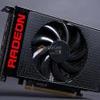A NANO Introduction
The AMD Radeon R9 NANO intrduction slash preview
The small form factor Fiji based graphics card air cooled
At the launch of the Radeon R9 Fury and Fury X AMD also announced something that caught the interest of many, a small form factor yet high-end graphics card aimed at powerful small game and HTPCs, yes the Nano today is announced. Now read that well announced as in, this is a paper launch. There are no benchmark articles available as the products have not been shipped to press, media and the channel and thus sales. The new AMD Radeon R9 Nano will be a 175W TDP graphics card based on a very small form factor The product has a fully enabled Fiji GPU with 4096 stream processors - 256 TMUs and 64 ROPs. The Fiji series of GPUs is latest next iteration of the GCN (Graphics Core next) architecture from AMD. Fiji is based on revision 1.2 GCN, just like Tonga (285 & 380 series).
| AMD Radeon R9 Fury X | AMD Radeon R9 Nano | AMD Radeon R9 390X | |
| Fabrication Process | 28nm | 28nm | 28nm |
| GPU | Fiji | Fiji | Hawaii / Grenada |
| Streaming Processors | 4096 | 4096 | 2816 |
| Graphics memory | 4 GB HBM | 4 GB HBM | 8 GB GDDR5 |
| Memory Clock | up-to 500 MHz / 1.0 Gbps | up-to 500 MHz / 1.0 Gbps | 6.0 Gbps |
| Core Clock | 1050 MHz | up-to 1000 MHz | 1050 MHz |
| Memory Bandwidth | up-to 512 GB/s | up-to 512 GB/s | 384 GB/s |
| Power Connectors | 2 x 8-pin | 1 x 8-pin | 1 x 6-pin - 1 x 8-pin |
| Form Factor | Full Height, Dual slot | Full Height, Dual slot | Full Height, Dual slot |
| Freesync | Yes | Yes | Yes |
| DirectX 12 Support | Yes | Yes | Yes |
AMD did pretty big things with Fiji though, they tucked away 8.9 Billion transistors on the GPU and that's the number without the memory. It gives them a staggering up-to 8.6 TFLOPS of performance to work with. At 28nm AMD applied the GCN 1.2 architecture, albeit you will learn that there have been a few tweaks at cache levels as the L2 cache is now 2MB for example.
The card will also hold 4 GB on the 4096-bit HBM memory interface with its memory ticking at 500 MHz (512 GB/s). An interesting step from AMD is the move towards a 4096-bit memory bus thanks to HBM. This is GCN 1.2, yet multitudes of it. The Fiji GPU as such has 4096 shader processors, these are clustered up in groups of 64 shader processors per CU (compute unit). 64 units times 64 shaders = 4096.
While the core clock frequency is allowed to boost up-to 1 GHz, the card has a temperature limiter. Once it reaches 75 Degrees C, it will start to down-clock to manage heat. As such the 1000 MHz core clock frequency is not a fixed clock on these cards, if the card passes its power limitations or overheats then the card would clock up/down in-between these monitored limiters.
The card will be based on four power phases for the GPU and two for the memory sub system. Since this will be a rather powerful mini-me of a graphics card, you need to hook it up towards and 8-pin PCI-Express graphics power connector.
According to the press presentation it will remain to be a very silent product, we measured the reference R9 290X at the time at 43 DBa at 75 distance, which is audible. This product 'should' be whisper silent. Next page please.






